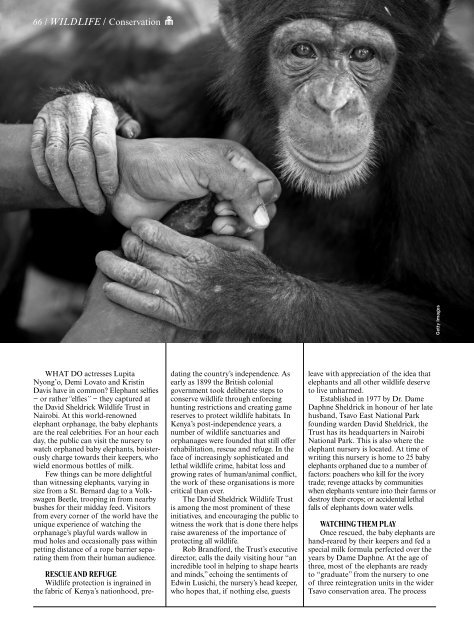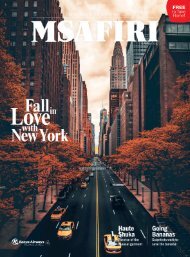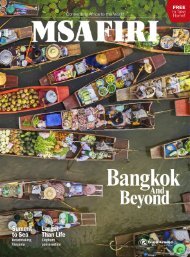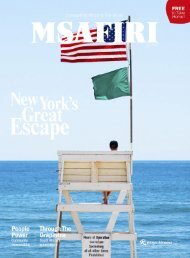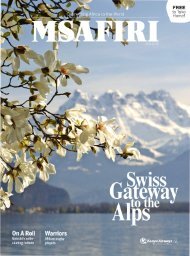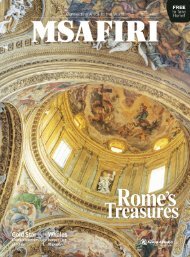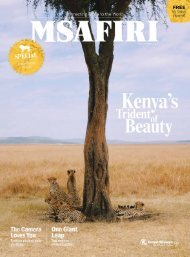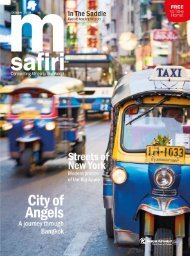Create successful ePaper yourself
Turn your PDF publications into a flip-book with our unique Google optimized e-Paper software.
66 / WILDLIFE / Conservation<br />
Getty Images<br />
WHAT DO actresses Lupita<br />
Nyong’o, Demi Lovato and Kristin<br />
Davis have in common? Elephant selfies<br />
− or rather“elfies” − they captured at<br />
the David Sheldrick Wildlife Trust in<br />
Nairobi. At this world-renowned<br />
elephant orphanage, the baby elephants<br />
are the real celebrities. For an hour each<br />
day, the public can visit the nursery to<br />
watch orphaned baby elephants, boisterously<br />
charge towards their keepers, who<br />
wield enormous bottles of milk.<br />
Few things can be more delightful<br />
than witnessing elephants, varying in<br />
size from a St. Bernard dag to a Volkswagen<br />
Beetle, trooping in from nearby<br />
bushes for their midday feed. Visitors<br />
from every corner of the world have the<br />
unique experience of watching the<br />
orphanage’s playful wards wallow in<br />
mud holes and occasionally pass within<br />
petting distance of a rope barrier separating<br />
them from their human audience.<br />
RESCUE AND REFUGE<br />
Wildlife protection is ingrained in<br />
the fabric of Kenya’s nationhood, predating<br />
the country’s independence. As<br />
early as 1899 the British colonial<br />
government took deliberate steps to<br />
conserve wildlife through enforcing<br />
hunting restrictions and creating game<br />
reserves to protect wildlife habitats. In<br />
Kenya’s post-independence years, a<br />
number of wildlife sanctuaries and<br />
orphanages were founded that still offer<br />
rehabilitation, rescue and refuge. In the<br />
face of increasingly sophisticated and<br />
lethal wildlife crime, habitat loss and<br />
growing rates of human/animal conflict,<br />
the work of these organisations is more<br />
critical than ever.<br />
The David Sheldrick Wildlife Trust<br />
is among the most prominent of these<br />
initiatives, and encouraging the public to<br />
witness the work that is done there helps<br />
raise awareness of the importance of<br />
protecting all wildlife.<br />
Rob Brandford, the Trust’s executive<br />
director, calls the daily visiting hour “an<br />
incredible tool in helping to shape hearts<br />
and minds,” echoing the sentiments of<br />
Edwin Lusichi, the nursery’s head keeper,<br />
who hopes that, if nothing else, guests<br />
leave with appreciation of the idea that<br />
elephants and all other wildlife deserve<br />
to live unharmed.<br />
Established in 1977 by Dr. Dame<br />
Daphne Sheldrick in honour of her late<br />
husband, Tsavo East National Park<br />
founding warden David Sheldrick, the<br />
Trust has its headquarters in Nairobi<br />
National Park. This is also where the<br />
elephant nursery is located. At time of<br />
writing this nursery is home to 25 baby<br />
elephants orphaned due to a number of<br />
factors: poachers who kill for the ivory<br />
trade; revenge attacks by communities<br />
when elephants venture into their farms or<br />
destroy their crops; or accidental lethal<br />
falls of elephants down water wells.<br />
WATCHING THEM PLAY<br />
Once rescued, the baby elephants are<br />
hand-reared by their keepers and fed a<br />
special milk formula perfected over the<br />
years by Dame Daphne. At the age of<br />
three, most of the elephants are ready<br />
to “graduate” from the nursery to one<br />
of three reintegration units in the wider<br />
Tsavo conservation area. The process


